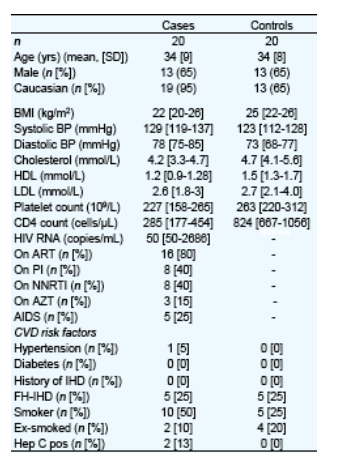 |
 |
 |
| |
Platelet Function & Heart Attacks in HIV+ & ART
|
| |
| |
Reported by Jules Levin
CROI 2009, Feb 8-12 2009, Montreal, Canada
"scientists at the Royal College of Surgeons in Ireland developed a novel assay (test) tied to HIV to measure platelet activity in blood. Platelets are essential for blood clotting when the skin is broken but, if they are dysfunctional within the bloodstream, they can cause clots within arteries which lead to heart attacks. Using this new test, the team from University College Dublin and the Mater Misericordiae University Hospital in Dublin, undertook clinical trials to investigate the activity of platelets among HIV patients in Dublin, Ireland. These findings show a significant increase in platelet reactivity"
Cases and controls were well matched for age and gender (Table 1). Cases tended to be lighter, have higher systolic and diastolic blood pressure, lower total and differential white cell count than controls. More cases smoked and had nearly double HOMA IR compared to controls.
A Case Control Assessment of Platelet Function in HIV-1+ and HIV-1- Individuals
Claudette Satchell*1, A Cotter2, E O'Connor2, A Peace3, T Tedesco3, A Clare2, J Lambert1,2, G Sheehan1,2, D Kenny3, and P Mallon1,2
1Univ Coll Dublin, Ireland; 2Mater Misericordiae Univ Hosp, Dublin, Ireland; and 3Royal Coll of Surgeons in Ireland, Dublin
Background: Although dyslipidemia, inflammation, and endothelial dysfunction have been linked to increased cardiovascular disease (CVD) observed with HIV-1 infection and ART, the role of platelets is yet to be determined. We hypothesised that HIV infection would disrupt platelet reactivity.
Methods: We compared platelet reactivity in 20 fasted HIV+ subjects and 20 matched HIV- controls by measuring time-dependent platelet aggregation (by light absorbance) upon exposure to increasing concentrations of platelet agonists adenosine diphosphate (ADP), collagen, epinephrine, and thrombin receptor-activating peptide (TRAP). We analyzed relationships between platelet aggregation and demographic, treatment-related and inflammatory parameters using regression with data presented as median [IQR] unless otherwise stated.
Results: Groups were matched for age (HIV+ mean [SD] 34 [9] years vs 34 [8] years for control) and gender (both groups 65% male). In the HIV+ group, mean [SD] CD4+ T cell count was 329 [204] cells/μL, HIV RNA was 50 [597] copies/mL with 80% on ART. In the HIV+ group, both ADP and TRAP induced less platelet aggregation at sub-maximal concentrations in a pattern suggesting non-competitive inhibition (ADP 70 [13]% vs 77 [15]% aggregation at 10 mM, p = 0.035; TRAP 75 [15]% vs 82 [12]% at 10 mM, p = 0..011 and 79 [11]% vs 86 [14]% at 20 μM, p = 0.012). In contrast collagen and epinephrine affected platelet aggregation in a pattern suggesting competitive inhibition. Collagen induced less aggregation at mid-range concentrations (5 [13]% vs 23 [61]%, at 0.07 mg/mL, p = 0.007 and 65 [27]% vs 73 [19]% at 0.14 mg/mL, p = 0.014) with the concentration of collagen required to induce 50% aggregation (EC50) higher in the HIV+ group (0.11 [0.06] mg/mL vs 0.08 [0.03], p = 0.012). In contrast, the EC50 for epinephrine was lower in the HIV+ group (4.19 [7.47] mM vs 19.7 [109.58] mM, p = 0.014). In multivariate regression, CD8 percentage and being HIV+ were independently associated with ADP-induced and TRAP-induced platelet aggregation respectively while higher neutrophil count and lower diastolic blood pressure were independently associated with collagen-induced platelet aggregation.
Conclusions: This is the first study to show platelet dysfunction at multiple levels in HIV+ subjects with both clinical and HIV parameters associated. Further research into underlying mechanisms and examining the effect of ART is needed to determine how platelet dysfunction links to CVD in HIV+ patients.
Table 1. Demographic and cardiovascular risk factors.

|
| |
|
 |
 |
|
|